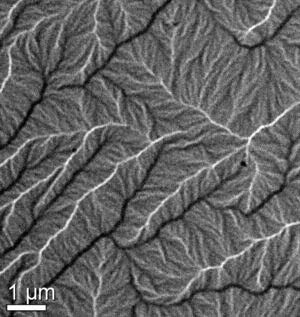Direct measurement of fluctuations in ferromagnetism
Physicists have long been able to measure very small thermal fluctuations in the magnetization of ferromagnetic materials (such as Fe), but measure similar fluctuations in antiferromagnetic materials. (Cr, for example) is much more difficult.
American and British physicists have for the first time measured these fluctuations in antiferromagnetic materials and surprisingly found them at low temperatures. This means that it can cause many difficulties when using antiferromagnetic materials in some spintronics storage devices and components (These results have just been published in Nature magazine 447).
Ferromagnetic materials (typically iron) contain small " regions " in which magnetic moments are oriented in a parallel direction. In all ferromagnetic objects in the demagnetization state, the magnetic moments of these regions (called domes) will orient in different directions, but when we place the magnetic field, the magnetic moments of the magnetic fields The direction of orientation in the same direction constitutes the magnetic degree of the magnetic object - and from this level is retained when the magnetic field is removed (residual magnetic state).

Ferroelectric plates (Photo: Vatlyvietnam)
It has long been known that thermal energy can cause sudden movements at the boundary between domes (called sodas). These disturbances can be noted by observing step steps in the magnetization process (called jump Bakhausen) when magnetizing ferromagnetic objects. However, measuring such fluctuations in antiferromagnetic materials is not easy. The problem is that these materials have magnetic moments arranged into two lattices that are parallel to each other and they are not from the whole mass. Therefore, these fluctuations cannot be recognized by traditional magnetic detection methods.
Recently, Shpyrko's team and colleagues at Argone National Laboratory (Chicago, USA) have developed a way to " eavesdrop " the fluctuations in the walls of antiferromagnetic metal by Cr. using the combined X-ray beam at the Argone's Advanced Photon Sourse radiation source, in collaboration with research teams from the University of Chicago (USA) and University College London (UK).
The group exploited a characteristic that antiferromagnetic properties in Cr mainly arise from conduction electrons rather than from magnetic moments of atoms. These electrons exist in the spin density waves (SDWs), where the electron spin density varies with the sin function (both in direction, magnitude) with the position - called the spin wave. . Although X-rays cannot directly detect spin waves, each spin wave is proportional to the charge density wave (CDW), where the presence of this wave can be recorded by How to use X-ray photon correlation spectroscopy (XPCS).

Diagram of engineering principles of measurement (a) and results (b) (Photo in Nature 447, 68, 2007)
The team used an X-ray beam to scatter on the Cr sample, creating an interference spectrum called spots that were recorded by a CCD camera. The exact presence of spotting spectra relates to the arrangement of charge density waves in small parts of the sample. By observing changes in spots over time, Shpyrko's team can observe changes in antiferromagnetism at distances as small as 1 micron.
Shpyrko told Physicsweb magazine that the group was also a bit surprised when observing doping fluctuations that occurred over a 1-hour period, at temperatures as low as 4 K. Physicists often view the wall as a structure quite large and requires a large enough heat energy to move. This result allows the researchers to assume that at very low temperatures, the walls of the diaphragm can be moved by the quantum tunneling effect.
The antiferromagnetic materials are currently being used extensively in computer hard drive readings and promise the potential for use in spintronics devices, which can control both the spin and charge properties of electrons in too information processing process. However, in future technologies that require location accuracy of these walls, this quantum tunneling effect can have certain effects. And according to Shpyrko, the solution could be to create defects or impurities in antiferromagnetic materials to halt this shift.
Now researchers are focusing on using this technique to study magnetic materials with both ferromagnetic and antiferromagnetic diodes. Shpyrko also believes that this technique could be used to study quantum phase transitions in antiferromagnetic materials.
The Doctrine of Independence
- Magnetic properties disappear at almost 0 degrees absolute
- A physicist proposes a uniform measurement system in space
- Why does the US use miles and feet to measure length?
- Warning about the type of application for fingerprint blood pressure measurement is very dangerous
- Atoms are 7 times smaller than we have ever known
- Found a new way to measure blood pressure at a very low cost, which is ... shooting video selfie
- Precise definition of temperature unit (Kelvin) thanks to laser spectroscopy techniques
- Use kite to measure the level of air pollution
- Electrophysiological stimulation enhances the ability to learn
- Big thighs are prone to cardiovascular disease
- First measurement of comet temperature
- Universal Converter - handy measurement unit converter
 Daily use inventions come from universities
Daily use inventions come from universities Special weight loss device helps prevent appetite
Special weight loss device helps prevent appetite 8 inventors were killed by their own inventions
8 inventors were killed by their own inventions Iran invented a motor car powered by water
Iran invented a motor car powered by water